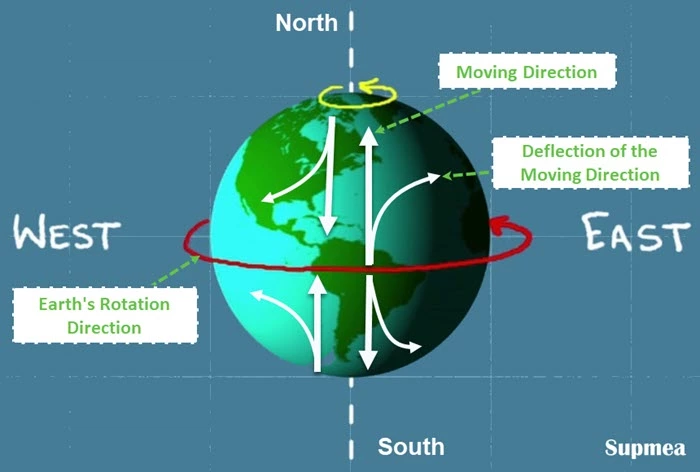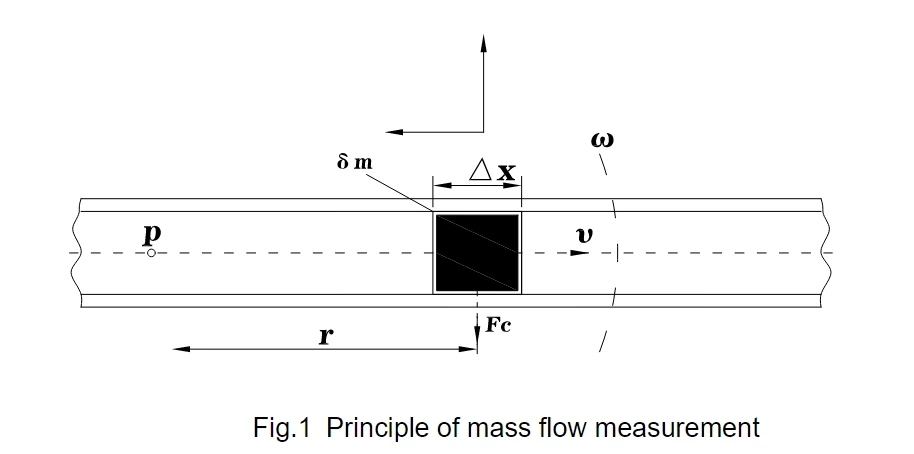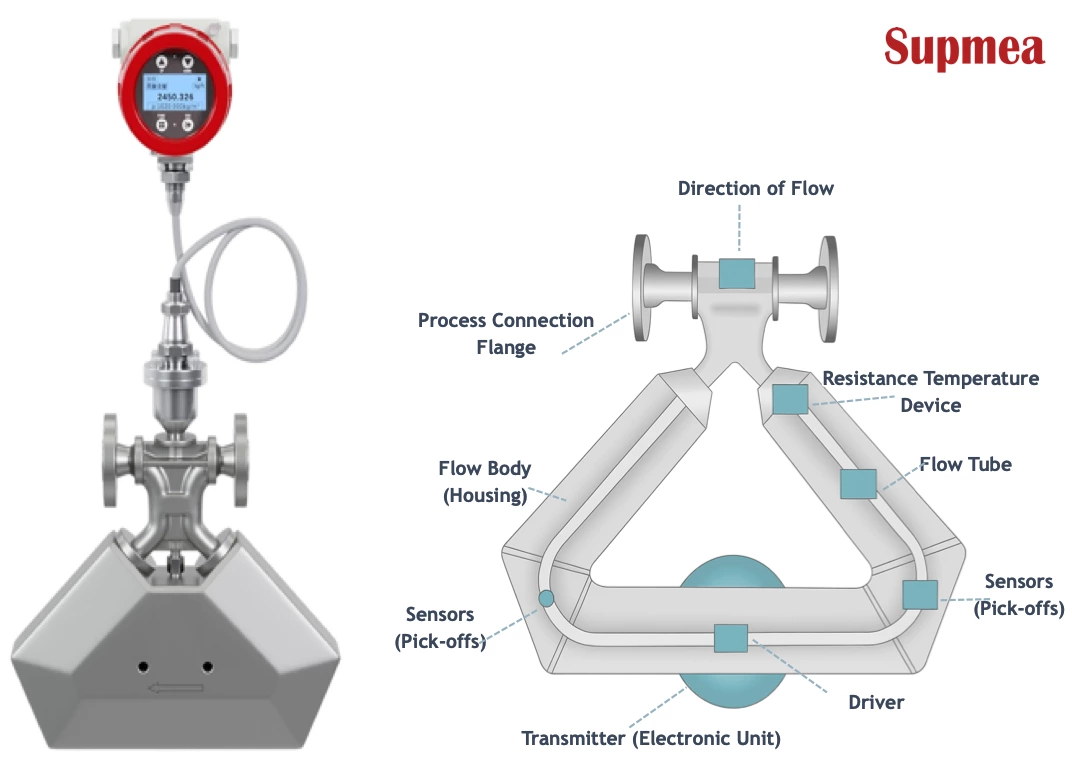A Coriolis Flow Meter Guide: Principle|Applications|Maintenance|Installation
Overview
A Coriolis flow meter, operating on the principle of the Coriolis effect (also known as the Coriolis force), is a pivotal solution for calculating flow in fluid measurements nowadays. With its accurate measuring and readings of the target fluid, it has been highly approved by worldwide customers and widely used in various types of gas and liquid processing plants.
In this post, we shed light on this remarkable flow sensor thoroughly, in which you will get the definition of Coriolis flow meter, understandable illustrations of its working theory, the demonstration of its benefits and limitations, its wide applications, selection tips for an optimum flow sensor, the tutorial of installation and maintenance, and the battle of Coriolis flow meter with other flow measuring meters.
Once you finish this tutorial journey, you will have a comprehensive understanding of it, no matter whether you're a noob or a new beginner who has some confusion about the advanced assistant.
What is a Coriolis flow meter?
A Coriolis effect mass flow meter is an impressive sensor used to measure the mass flow rate, density, and temperature of target fluids based on the Coriolis force, or in formal terms, the Coriolis effect.
It offers precision with up to ±0.1% or better, which boosts it to rank high among loads of gas and liquid measurement machines and gains loads of approval from worldwide customers.
What is the Coriolis effect?
The Coriolis effect or principle can originate from the research concluded by three priests: Giovanni Battista Riccioli, Francesco Maria Grimaldi, and Claude François Milliet.
The first two Italians stated that the rotation of the Earth should cause an east deflection of a cannonball aimed north. Claude François Milliet, a French priest, illustrated how the rotation of the Earth triggers a deflection in the trajectory of both falling objects and the projecting lines pointing to the two poles of the Earth.

Based on this research, a French mathematician, Gaspard-Gustave de Coriolis, published a paper that included the supplementary forces detected in the rotating frame of reference.
He classified the supplementary forces into two categories, in which the second category contained a force that arises from the cross product of the angular velocity of a coordinate system and the projection of a particle's velocity into a plane perpendicular to the system's axis of rotation.
Then, Coriolis named this force the "compound centrifugal force" for its analogies with the centrifugal force that has appeared in the first category already.
These perceptions raised by Coriolis promoted the "Coriolis force" to the public, which was known as the "acceleration of Coriolis" in the early 20th century and as "Coriolis force" in 1920. (from Wikipedia.org)
Based on this sophisticated principle, a Coriolis flow meter can measure the flow rate of given fluids in collaboration with its intricate assembly units.
Recalling the Coriolis flow meter
Taking the Coriolis effect as the theoretical foundation, the Coriolis flow meter was then invented -- to resolve the long-existed trouble in engineering: how to measure the mass flow of a fluid accurately, especially when temperature or pressure changes affect the volume measurement?
In the early 20th century, most flow meters relied on mechanical methods. For instance, the turbines or paddle wheels worked well for volume, but not so much for actual mass. This became a big problem for industries that desired accurate measurements, like oil, gas, or chemical processing plants.
Then it came to the 1950s and 60s, when the real shift happened. Engineers began to adopt the Coriolis effect — a force that acts on objects in motion within a rotating frame (like Earth) to measure mass flow directly. It wasn't until the late 1970s, this idea turned into something practical.
Until the late 1970s, this perception came into reality. A man called Jim Smith developed a flow meter that used vibrating tubes instead of the spinning parts to proceed with the measuring. As the fluid moved through the vibrating tubes, a twist was generated. By measuring this twist, the professionals could then calculate mass flow with high accuracy. This innovation laid the foundation of the later Coriolis mass flow meter.
In 1977, Smith's company, Micro Motion, released the first commercial Coriolis flow meter lineup. This early Coriolis sensor attracted great attention for its precise and reliable measurements and readings of flow rate, density, and temperature.
By the 1980s, other Coriolis mass flow meter manufacturers, like Endress+Hauser, Rheonik, and Krohne, joined this fierce competition to seize the market share with their unique products.
Over time, the Coriolis mass flow calculator became more compact, more affordable, and more widely adopted. Today, it is used in a wide range of applications, from food factories to fuel pipelines for its all-in-one measuring ability.
Coriolis flow meter's inner structure
Now that we have figured out the basic info of the Coriolis effect mass flow sensor, let's explore its inner structures, so that we can learn how these components collaborate to provide the correct measuring and reading.
The most common Coriolis flow meters include U-type, triangular type, straight tube, micro-bend, continuous loop, single tube, and dual tube. Although they look different from the outside, inside, however, they are packed with the same smart engineering. So, if we know one, we know all.
Here, we separate a Coriolis effect mass flow meter into small units for detailed illustrations:
Flow Tubes: The tubes are one of the key parts, soldered with a Coriolis sensor that flows the target fluids with stainless steel or other corrosion-resistant materials for durability. Once the gas or liquid is in motion, the flow tube oscillates with a specific frequency.
Driver (Oscillator): This object keeps the flow tube oscillating and sends a steady input signal to make sure the oscillation stays consistent as the fluid is moving through.
Resistance Temperature Device: This sensor monitors the temperature carefully. Once the temperature increases, the sensor resistance increases immediately.

Sensors (Pick-Offs): Located on both ends of the vibrating tubes, these sensors detect the tube's motion and twist. They measure the time lag between vibrations, which directly relates to how much mass is flowing through the meter.
Transmitter (Electronics Unit): This part receives signals from the sensors, processes the data, and calculates mass flow rate, density, and sometimes even the temperature. It then outputs the info to the control system.
Flow Body / Housing: This is the outer casing that protects all the components. It also provides the connection points for your pipeline. It’s typically made of stainless steel or other durable materials in case this sensor is always exposed to a harsh working environment.
By the way, if you're curious about the physics behind the twist, you can ponder on this neat equation:
F = −2m(ω × v).
Where:
- m is the mass of the fluid,
- ω is the angular velocity of the vibrating tube,
- v is the velocity of the fluid inside.
This formula tells us that the amount of twist (the force) depends on both how fast the fluid is moving and how much of it is flowing.
More mass or higher speed means more force — and that results in a stronger twist in the tube. The flow meter reads this twist and converts it into a highly accurate mass flow rate reading afterwards.
Since the Coriolis meter doesn’t rely on external factors like pressure, temperature, or fluid state, it delivers extremely precise readings — no extra compensation needed, anyway.
Coriolis flow meter's working principle
Here we can illustrate the Coriolis flow meter's working pattern in this way: if a pipe is rotated around a point (P) while the fluid is flowing through it (toward or away from the center of rotation), that fluid will generate an inertial force, as shown in Fig.1:

The particle of mass δm moves to the right in the tube at a constant speed υ, while the tube rotates around a fixed point P at an angular velocity ω. At this time, the particle will have two acceleration components:
(1) Normal acceleration αr (Centric acceleration), its value is equal to ω2r, which is directed towards point P.
(2) Tangential acceleration αt (Coriolis acceleration), whose value is equal to 2ωυ, and the direction is αr perpendicular. The force produced by the tangential acceleration is called the Coriolis force, and its magnitude is equal to Fc=2ωυδm.
In the Fig.1 table, the fluid Δm=ρA×ΔX,
So, the Coefficient of friction can be expressed as:
ΔFc=2ωυ×δm=2ω×υ×ρ×A×ΔX=2ω×δqm×ΔX
where A is the cross-sectional area of the tube:
Δqm=δdm/dt=υρA
For a specific rotating tube, its frequency characteristics are certain; ΔFc depends only on δqm. Therefore, the mass flow can be measured directly or indirectly by measuring the Coriolis force.
Coriolis flow meter's wide applications
Due to the Coriolis flow meter's correct reading and seamless working, you can find its presence in a variety of industries, from chemical to food and beverage. Here, let's derive its character in various kinds of industries:
Coriolis flow meter in the chemical industry
Coriolis effect mass flow meter holds a primary station in monitoring and controlling the critical flow rates of fluids like acids (sulfuric, nitric), bases (sodium hydroxide), solvents (toluene, acetone), resins and polymers, viscous or shear-sensitive materials, hazardous or flammable liquids in the chemical industry.
Thanks to its corrosion-resistant design, it can be exposed to a harsh working environment to deal with corrosive fluids.
The data reported by it not only indicates that the processing goes well with no anomaly involved, but also guarantees the product quality. On top of that, its precise measurement of target gas or solvent assistants improves efficiency and reduces waste.
Coriolis flow meter in the food and beverage industry
The food and beverage processing plant is another stage where the Coriolis flow meter presents its remarkable functionality. It most often shows up in the following cases: milk and dairy processing, syrup and juice blending, beer and beverage filling lines, cooking oil and fat measurement, flavor and additive dosing, fermentation control, custody transfer of high-value liquids like wine or spirits, and so on.
With compatibility of CIP/SIP and no moving parts, this flow sensor provides higher efficiency and maintains a trusted lineup quality with low maintenance. It is greatly welcomed by food and beverage manufacturers, orchard owners, juice or jam factory owners, etc.
Coriolis flow meter in the oil and gas industry
High demands for Coriolis flow sensors from the oil and gas industry make it indispensable among all fluid measurement solutions.
You can discover it's busy in loads of oil and gas further processing, like crude oil measuring at wellheads, chemical injection, multiphase flow monitoring, custody transfer of crude oil and refined products, pipeline leak detection, blending and batching at terminals, refinery process control (hydrocarbons, fuels), and product loading/unloading.
Independent of pressure and temperature, it measures and reads the flow rate of gas and solvents super accurately, making itself stand still in fluid measurement fields.
How to choose a Coriolis flow meter?
When determining whether and what a Coriolis flow meter suits your industry, multiple factors should be taken into consideration. Not until a comprehensive evaluation and thinking are given can you sort out an optimum sensor that matches your industrial process perfectly. We list all the factors here, one by one, to instruct you in the Coriolis flow meter selection:
Type of fluid
The first factor that you should consider is the target fluid the flow meter deals with. A Coriolis flow sensor works well in measuring gas, liquids, slurries, or viscous fluids. If the measured target belongs to any item above, then proceed with the following tips to sort out the most suitable flow sensor.
Flow rate range
Knowing the flow rate range based on the measured target is important for choosing an appropriate Coriolis flow meter. Typically, a gas and liquid flow sensor performs best within its flow rate range. Too much or too little over the range results in unexpected errors.
Therefore, choose a Coriolis flow meter with a proper flow rate range provided by the Coriolis flow meter manufacturers.
Pipe size and process connections
Due to the fluid's volume and flow speed varying in industries, Coriolis flow sensor vendors always produce flow meters with different inlet and outlet pipe sizes to offer customizable services.
On top of that, the process connections alter along with the change of flange types, sanitary fittings, or threaded ends tailored to industries.
Hence, it's necessary to consider these two aspects when choosing the right Coriolis principle-oriented flow sensor.
Temperature and pressure range
Most Coriolis flow sensors can deal with 150 degrees; you can choose one based on your industrial demands.
If you have industry processing fluids with a larger temperature range, then the product from Supmea is an incomparable choice. The Supmea Coriolis effect mass flow sensor is configured with advanced components to handle temperatures from -200℃ ~ 300℃, matching your industrial process completely!
Material compatibility
Mostly, the Coriolis effect-based flow meters are made up of 316L stainless steel, hastelloy, titanium, and PTFE-lined to operate in different cases.
The stainless steel is for common use, the hastelloy or titanium one is often seen in corrosive fluids, while the PTEF-lined always deals with the aggressive chemicals.
Installation orientation and space
The installation orientation of a Coriolis flow sensor is dependent on the flow direction, which can be horizontal or vertical. You can determine which Coriolis sensor once you evaluate the installation direction and space in your factory.
Outlet signals and integration
Checking what signal types your systems require is of vital importance. The standard
Industry standards and certifications
Based on your industry, the standards and certifications vary. For example, the food and beverage industry requires the 3-A and EHEDG certifications, the Hazardous areas have demands for ATEX, IECEx, and FM certifications, while for quality systems, the ISO, CE, and SIL are necessary.
You can check whether the Coriolis flow sensor you prefer has related certifications to reduce any mistakes as much as possible.
Budget and performance
Budget and performance are the last yet significant factors taken into consideration. Too high a budget results in waste, while too low a budget triggers insufficient performance. Therefore, you ought to value your budget and ROI target. Commonly, the entry-level sensor device is suitable for general flow monitoring, while premium ones are perfect for critical custody transfer and batching.
Do not forget to consider installation, maintenance, and downtime in the budget!
If you consider all factors above before purchasing, then you definitely can select perfect Coriolis flow meters matching your industrial requirements seamlessly!
Supmea Coriolis mass flow meter comparison
Supmea company offers three Coriolis mass flow meter types, including a straight tube, a triangular one, and a non-straight tube. Aimed to deal with varying cases, these Coriolis principle-based machines are configured with different components. Let's have an overview:
Coriolis flow sensor's installation and maintenance
How to install a Coriolis flow meter? This question might be the most highly searched one after a customer purchased a flow meter. However, although the sensors shipped from different vendors are built with various parameters, the installation rules are the same to a large extent.
You can visit this Coriolis sensor installation guide to gain the info on how to install a Coriolis flow meter, which also includes the details on maintaining the measurement sensor operated by the Coriolis working principle.
Coriolis flow sensor's advantages and limitations
Since we have concentrated on this accurate sensor on so many aspects, now let's conclude its advantages and limitations fairly.
Coriolis flow meter's advantages
Indeed, the Coriolis effect mass flow sensor owns loads of remarkable benefits, making it rank high among all sorts of fluid measurement solutions:
- It's insensitive to viscosity, temperature, and pressure.
- It can be modified to measure the mass flow in either the forward or the reverse direction.
- It's configured with no inner moving parts, which might be corrupted or jammed by the particles of viscous liquids or slurries.
- It is independent of the Reynolds number. (A dimensionless number used in fluid mechanics to predict flow patterns in different fluid flow situations: whether the flow will be laminar, transitional, or turbulent.)
- It needs no outer measuring assistant when measuring the temperature, density, and flow rate of the target fluids.
- It offers high precision measurement and readings for its compact and seamless design.
Limitations of the Coriolis flow meter
- Coriolis flow meter is expensive.
- Coriolis flow meter struggles to deal with the low-pressure gas measurement.
- Coriolis flow meter cannot offer suitability for the large pipelines.
Final words
This post walks you through a Coriolis flow meter from an all-around perspective. Once you read it, it's sure that you won't be puzzled about this flow measurement any longer. If you prefer further info or details about a specific product, please feel free to contact us with no hesitation!




